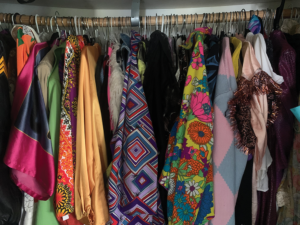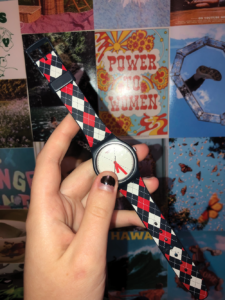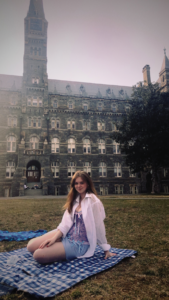Amanda Estevez (COL ’23) is the owner of a closet that could double as a thrift store.
Contained in a single rack spilling over with bright colors, loud patterns and varied textures, their clothing collection is a bona fide blast from the past. As they pull out their favorite pieces in a Zoom interview with The Hoya, their face lights up as they explain the story and inspiration behind every item.
Social media has played a prominent role in the repopularization of ’70 and ’80s fashion fads. On TikTok, videos about dressing in a 1980s-inspired style or searching through old clothes to find trendy pieces fill the feed. From crochet to silk scarves, kids born in the early 2000s have been drawn to vintage styles through social media in anticipation of the upcoming summer.
With recent pop culture phenomena referencing the past, from the nostalgic 1960s costuming of “The Queen’s Gambit,” to Harry Styles’ retro fashion to the reemergence of the Juicy tracksuit, students have more exposure than ever to retro trends.
Estevez is no exception to this phenomenon of the reinvigoration of classic retro silhouettes. They incorporate vintage pieces into their wardrobe, making a conscious effort to emulate the past in their personal style. To Estevez, their age and identity as a college student has caused them to look backward for style inspiration because they feel that now is the perfect time to dress outside of the box through their eclectic combinations.

“Right now, we’re at a pivotal time in our lives to be able to experiment and tap into ourselves and what we like and just try new things,” Estevez said in a Zoom interview with The Hoya. “If vintage clothing and trying to find pieces that call out to you are part of that journey, then absolutely go ahead.”
Throwback on the Rack
Seasoned vintage wearers rarely look to the runways for fashion inspiration.
Instead, people like Estevez seek out vintage clothes on a piece-by-piece basis, choosing whatever calls to them in vintage stores, online or even in the archives of their own wardrobes.
Estevez has a few special items that speak to them again and again. They make a point of trying to find such pieces when they are shopping, especially jumpsuits, turtlenecks and corsets. When speaking about their favorite pieces in a Zoom interview, they held up a pastel floral tunic for the camera.
“Some days, I want to look like a mod girl from 1965 with this dress, which is from the 1960s,” Estevez said. “It’s so beautiful; it’s like a tunic dress. I pair it with my go-go boots. I have purple go-go boots, but my current favorites are my silver ones.”
Like Estevez, Audrey Wills (SFS ’23) is also drawn to corsets as a way to bring the past into her eclectic style. Both of their wardrobes are heavily inspired by ’70s and ’80s fashion trends, and Wills’ Instagram features many photos of her in thrifted or nostalgic clothing items. Although neither Wills nor Estevez are fashion experts, they have taken the trend of vintage clothing and enveloped it in their own styles.
While Estevez’s clothing choices pull more from the 1960s and ’70s, Wills is inspired by the 1980s and early 2000s. When elaborating on her favorite pieces, Wills called out certain patterns and silhouettes in particular, and gestured to the argyle watch on her wrist.

“My Swatch is one of my favorite things ever. I’ve had it since I was a sophomore in high school, and it’s argyle and very ’80s, and I was just obsessed with it at the time,” Wills said in an interview with The Hoya. “I love my corset; I wear it a lot. I’ve been very into low-waisted jeans lately, which is something I never thought I would say.”
In a different approach from Wills and Estevez, Lily Yamagata (MSB ’23) alters her clothes to make them appear more vintage than they really are. For her, dressing in a way that reflects the past half-decade has less to do with individual pieces and more with the inspiration she finds in visual art. She takes everything from her personal interests to the environment into account when building her closet.
“I’ll buy jeans that are twice my size, hem them down and then bleach them to make them how I want them or dye them so that it’s better for the environment and I’m still getting the type of clothing that I want,” Yamagata said in a Zoom interview with The Hoya.
Spontaneity and variety are readily apparent in these students’ closets. When taken together, the vastly different pieces they choose cover a broad timeline of vintage inspiration. Wills has even cleverly named a few items in her closet, embracing the diverse range of her clothes.
“I just have a lot of random things because it’s just a collection of what I like, and what I like doesn’t really fall into one category,” Wills said. “So I have what I call my ‘Disney Mom Tops,’ which are like long-sleeved, printed boatneck shirts that look like they would be on a mom in a Disney Channel original movie. Then I’ve got my ‘Britney Spears Pants’ which are low-waisted camo with embellishments on them.”
Shopping for Inspiration
Seeking to diversify their closets, fashion-savvy students turn to art, their hometowns and family backgrounds for style insight. Finding pieces that reflect their interests and drawing inspiration from their favorite media helps each individual express their own fashion sense.
Parallel to the rise of vintage inspiration from social media, there has also been a rise of short-lived fads, contributing to mass consumerism through an increase of quick clothing fads. Brands like Zara add new clothes to their websites regularly and quickly, contributing to fast fashion and decreasing the popularity of classic looks with greater longevity.
Wills does not look to celebrities or influencers for creative motivation; rather, she gravitates to outfits from her favorite childhood TV shows, a source of inspiration that reemerged while she lived at home during the COVID-19 pandemic.
“I’m inspired less by specific people and more by media,” Wills said. “‘Totally Spies’ was my favorite show growing up, and I re-watched it when quarantine first started as a comfort thing, and I was just shook by how amazing the outfits were on this animated children’s TV show.”
Similarly, Yamagata expresses her artistic creativity through her style, connecting her retro fashion sense to her pop art paintings and sketches. In a Zoom interview with The Hoya, Yamagata pointed out some of her favorite art pieces she has made, which now hang above her bed, highlighting a link between it and her expressive, vibrant clothing taste.
“I also take a lot of inspiration from the ’70s in my artwork, so there’s a huge correlation between what I wear and how I paint,” Yamagata said.
Estevez and Wills both find connections between their hometowns and their fashion senses. Estevez turns to Los Angeles, their hometown, and Washington, D.C., where they know there will be vintage shops to find new pieces. Shopping in thrift stores is an ethical stance when it comes to the environment, and although the moral status of thrifting is debated, Estevez believes it is better than the alternative. According to them, large brands’ fast-fashion production to put out vintage-inspired clothing is an issue.

“In terms of the trendiness of vintage clothing, I would say that it leaks into the issues of the fast-fashion industry because now we have big fast-fashion houses taking vintage designs and making them into something that’s easily disposable,” Estevez said. “I wouldn’t say that that keeps the authenticity of vintage clothing and of what it honestly means because each piece has its own story.”
Wills has been able to frequent thrift stores in Texas, broadening her closet with staple pieces without leaving a large environmental footprint. Having access to so many hole-in-the-wall vintage stores when looking for new pieces is a blessing, according to Wills.
“I thrift a lot when I’m home. My parents live in Texas, and they live in a part of Texas that’s very much antique stores, vintage shops, thrift stores, which is incredibly lucky for how I like to present myself,” Wills said. “I like to thrift, and a lot of it is just finding interesting pieces that I can center an outfit around.”
For the Right Reasons
Anna Van Lenten Crowley (COL ’20) has increasingly used style to get creative and quell her boredom during the pandemic, turning to fashion as an escape from quarantine monotony and endless virtual meetings.
“It became a part of my day where it was the thing that I looked forward to,” Crowley said in a Zoom interview with The Hoya. “Instead of getting dressed to go and do something, it was like getting dressed for the fun of it and playing dress up in a way, hoping that it would be something that’s gonna put a smile on my face.”
Wills said she actively works against Georgetown University’s buttoned-up, preppy norm with her style. A carefree mentality when it comes to fashion is key as a young person, according to Wills.
“I think so much of it is a mental thing, and it can be really interesting at a place like Georgetown where the community tends to be a lot preppier than what I grew up around,” Wills said. “So much of it is being like, ‘No, screw it, I’m 20; my body’s never gonna be this good again in my entire life. I’m gonna wear what I want.’”
Similar to Wills, Estevez feels their youth is a huge part of her ability to dress how they want. They have observed that younger generations have an easier time drawing from the past when it comes to their personal styles but reject the idea that one must stop experimenting with clothes once they are older.
“Something that I have noticed is that as people grow older and the hardship of life kicks in, they’re like, ‘Oh, I have to tone it down,’” Estevez said. “But that’s something that I never want anyone to feel. You don’t have to turn yourself down to meet the expectations of society.”
Ultimately, Estevez is glad to see others reaching into the past when compiling their wardrobes. Now more than ever, escaping to a different time period can be essential to self-expression, according to Estevez.
“I love the fact that people are feeling like they can express themselves through vintage clothing and through tapping into a different time period because right now it’s a weird time to be alive,” Estevez said. “If clothing can be something that comforts people and just allows for a greater sense of self, that is what is the most important.”














[email protected] • May 24, 2021 at 1:02 am
What can I say, I could feel the love and passion in this article, I’ve had this same feeling for over 40 years plus … vintage clothes rocks 👍👍👍